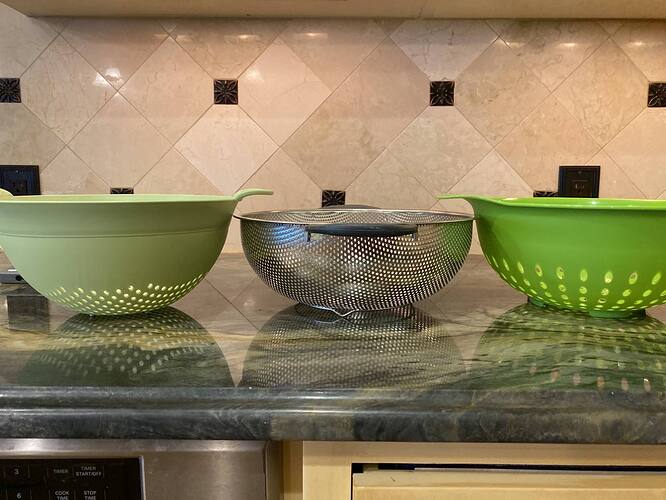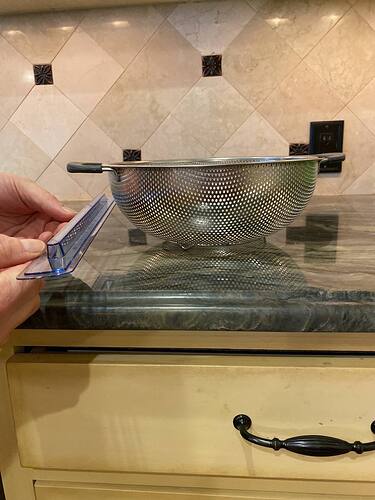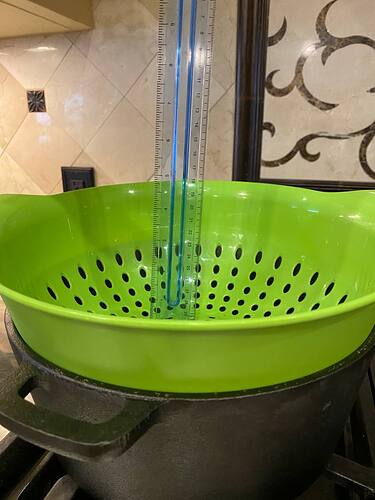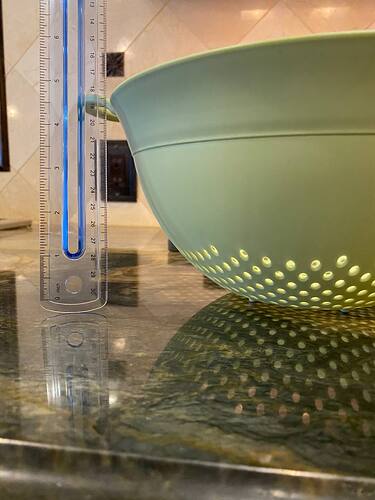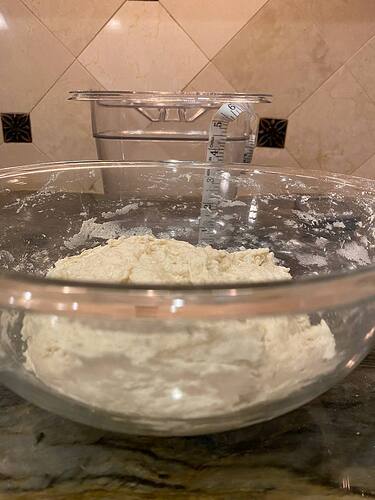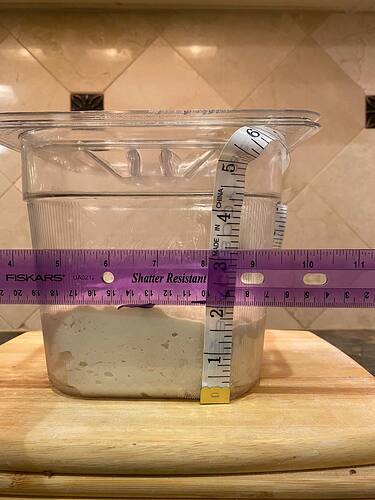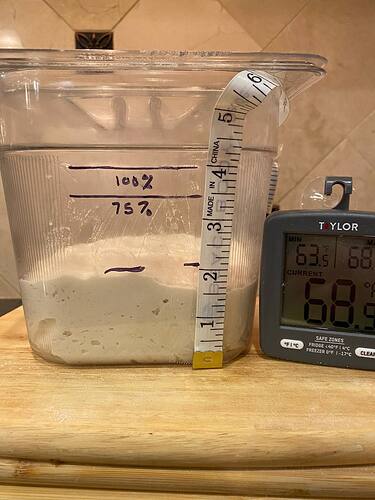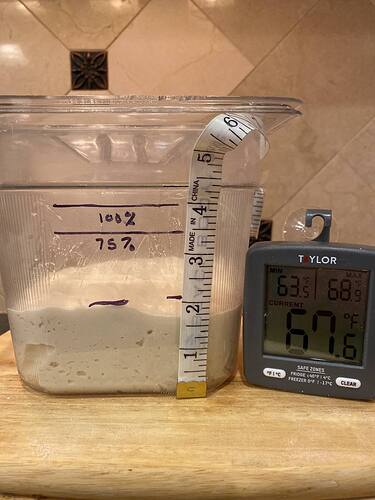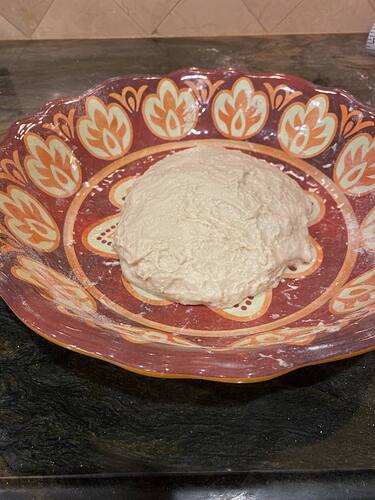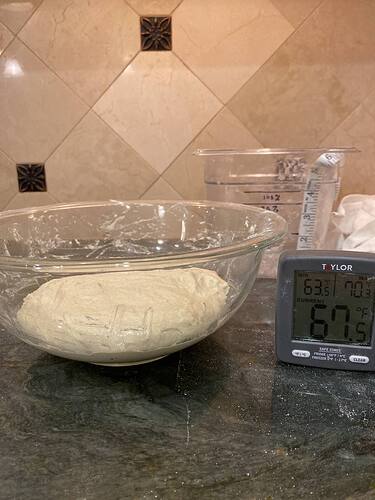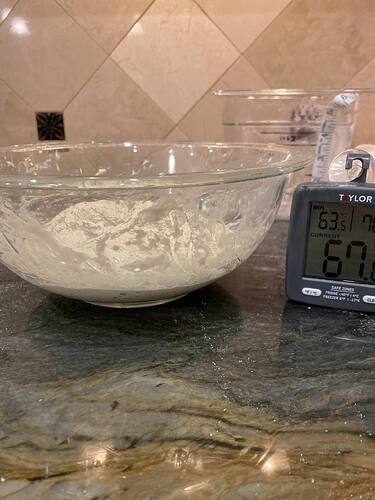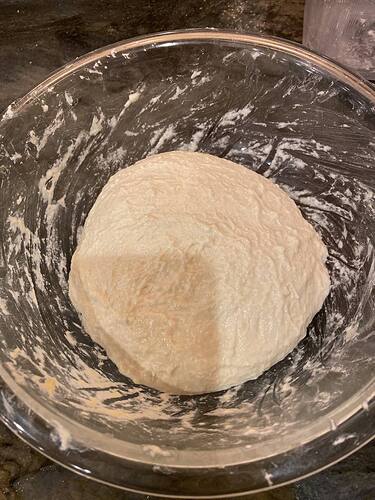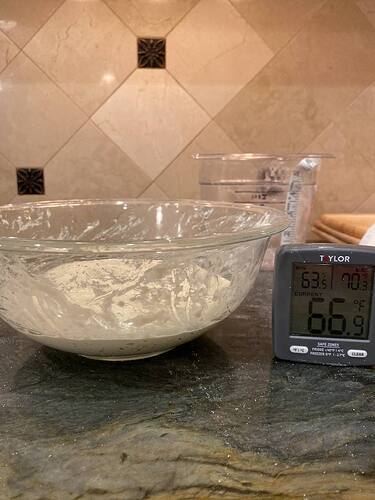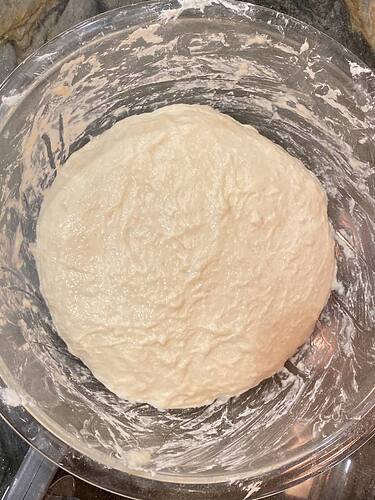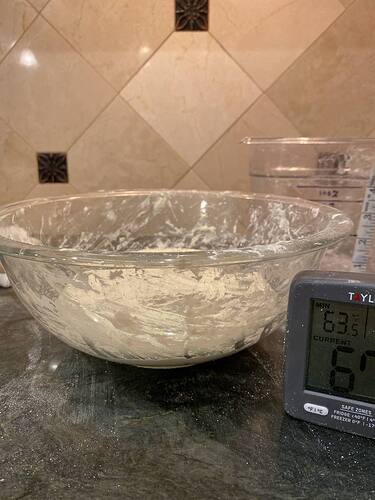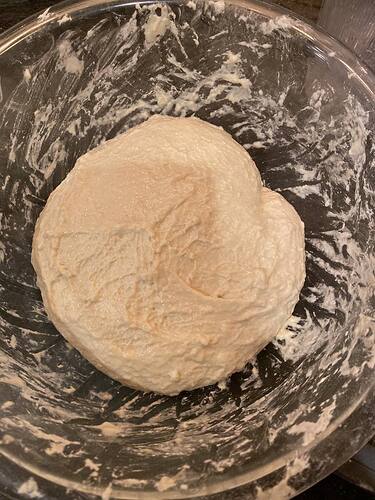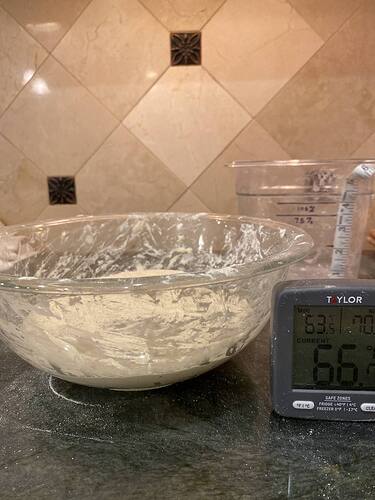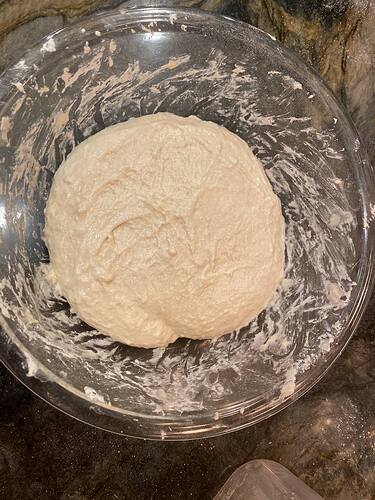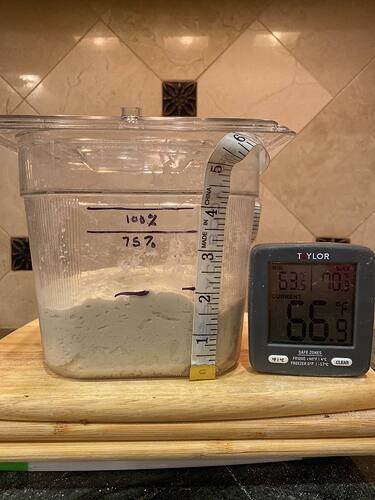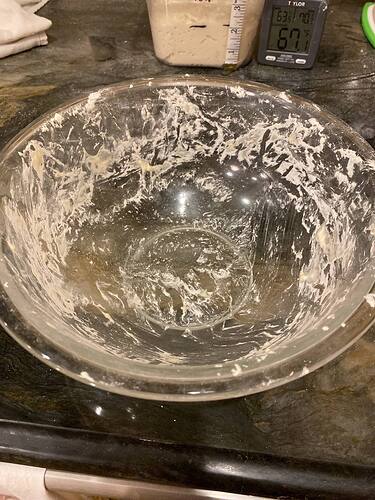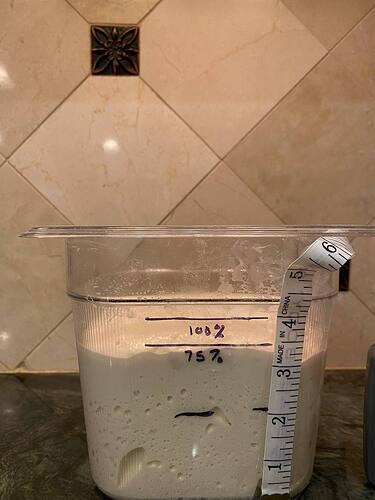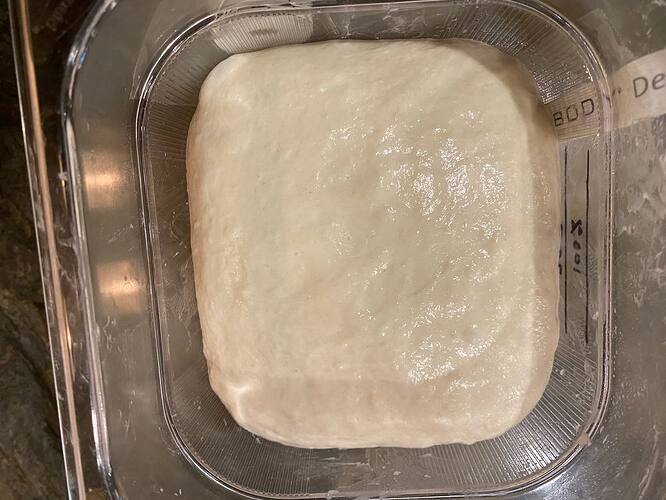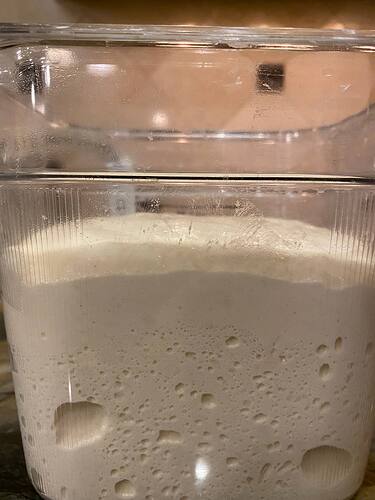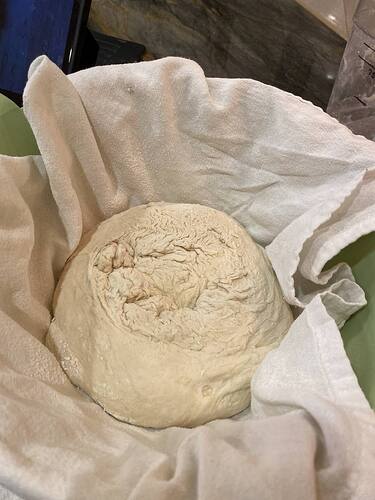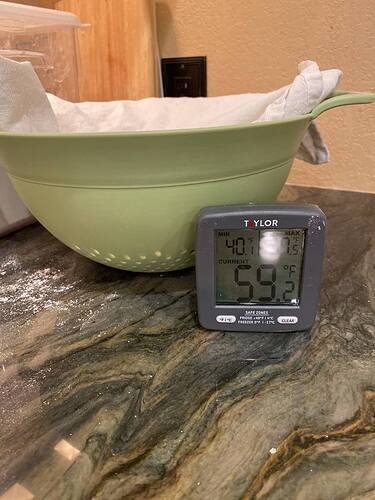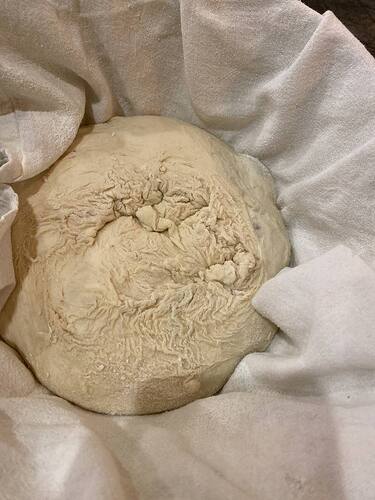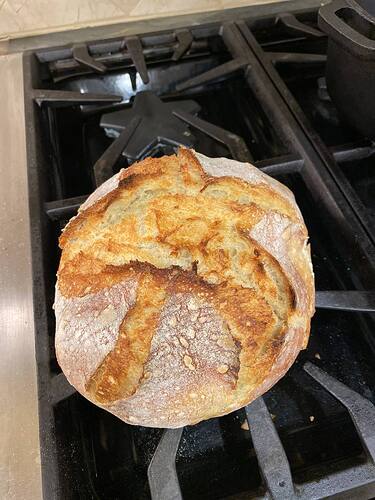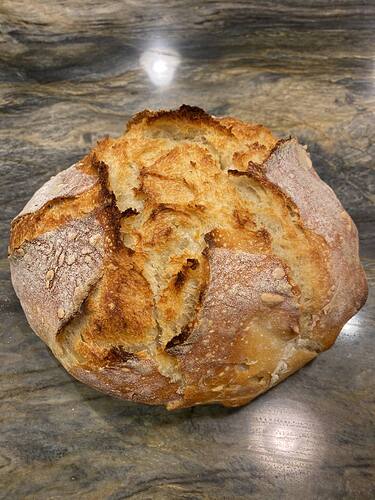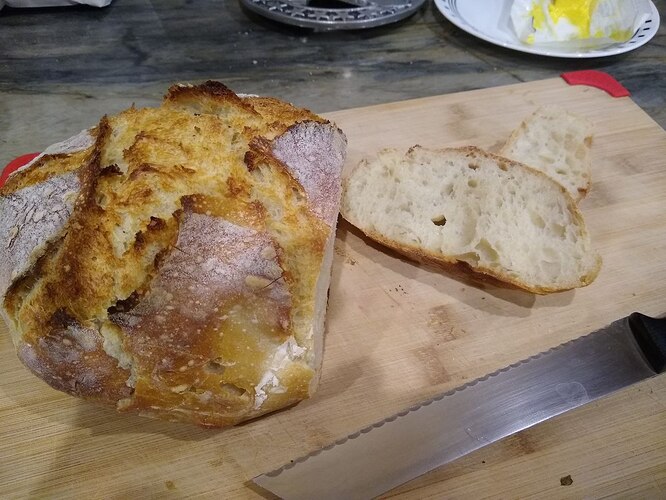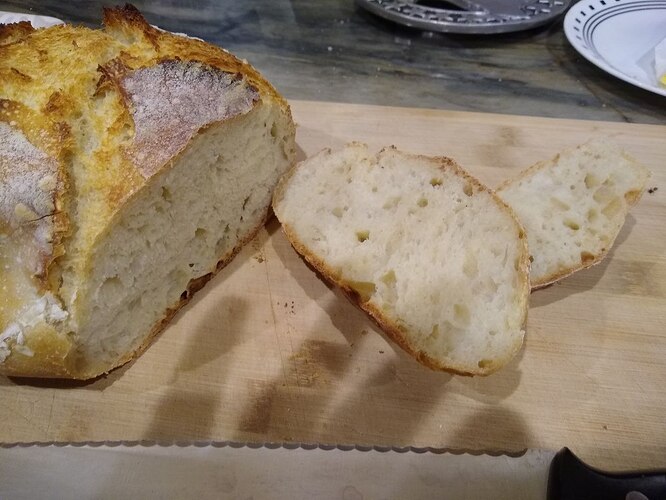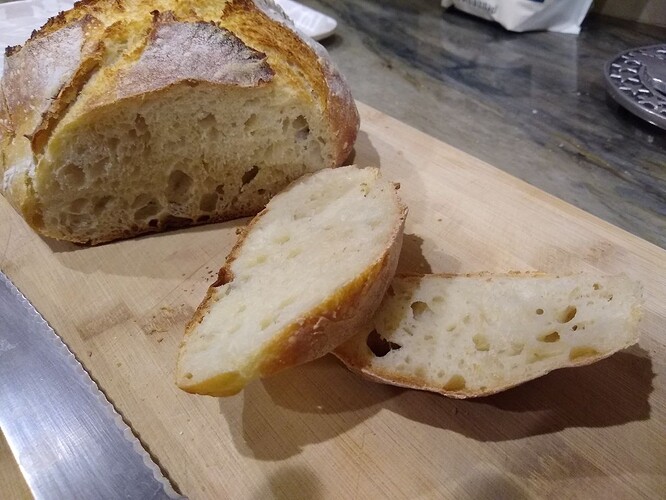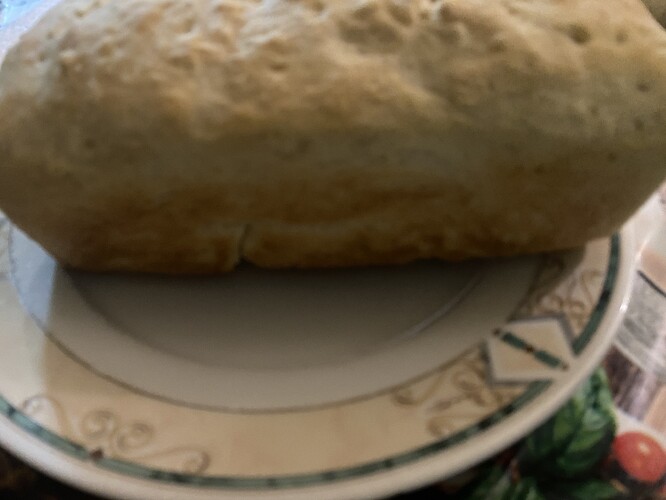The Making of Beginner’s Loaf #3
Temperature of area where the dough will be prepped, kneaded and proofed in the preceding 24 hours ranged: 63.5F to 67.6F
1g of yeast was bloomed with 5g sugar in 60g of 107F water for 5 minutes
455g sifted AP flour, 9g of salt and 300g of 87F water were mixed with the proofed yeast until combined and set to rest for 15 minutes.
Picture after the 15 minute rest
Wet fingers and removed dough from bowl into lightly oiled hardsided container with lid:
Measured initial dough height at 2 inches:
Calculated a 75% rise would be 3.5 inches, a 100% rise would be 4". Marked those on the container.
As you can see the temperature is 68.9F at the time the dough is left to rise. Timer set for 25 minutes.
After this first rise the dough has risen.
Had to remove dough from this receptacle to do a round of stretching and folding. This is a picture after the first round of S&F:
I realized I chose the wrong diameter bowl for this step so I transferred it back to the bowl I initially mixed the dough in. I had to preform additional stretch and folds to get the dough in the right shape for resting. Here it what it looked like after it’s 2nd stretch and folds after the transfer:
The dough looked like this after 25 min rest following the first stretch and fold:
The second stretch and fold was easier to do but I am still having a lot of trouble with the last ‘pick up and fold over’ part of the maneuver.
Here are two shots after the 2nd S&F, side and top. You might notice the bowl is getting MIGHTY messy- nothing like the clean bowl from the video. I am using some water on my hand but there is goo everywhere. This loaf will be smaller just by attrition…
Rested for 25 minutes and here is the look before starting last S&F
I watched the demo video for the 287th time but this time counted the number of Stretches (4) and then the number of Folds (5) that end with a small, deliberate press at the end. I followed this to the T and this went better- of course the dough is getting easier to handle all the time. My fold over was possibly a bit easier… that’s the toughest part.
After S&F #3
I decided to let it rest in this bowl for 25 minutes before transferring back to the clear square container to finish BF. Here are the shots after that rest.
So this baby was finally allowed back in the secure confines of the hard plastic resting place with lid on to preserve hydration- I gave him plenty of water in all my stretch and folds and the bowl was still a Mighty Mess!
The dough first went into Hard Side at 6:27.
After all the S&Fs and resting he was back in Hard Side at 8:19.
Crusty Loaf rigged up a camera to remotely monitor progress and here he is at 9:27
if I compare these side by side I can see air starting to form in the dough in just this short time. He will remain on the granite without the under counter light on because that light is halogen so its hot.
The cutting boards were in the first shot because I was trying to get even with Hard Side while resting my phone on the counter. They were merely for that one shot. All other times the bowl or Hard Side were on the cold stone.
The temperature did rise in that area early on because CrustyLoaf fired up the oven and range to make dinner- I know… but he has not adjusted to the bread making modification underway in our kitchen. There is an oven right below the space I’m using and I will have to move areas if that is needed while proofing, or adjust my tactics.
So I’m coming to the day’s end as I write this up and see another hour has passed since the last photo so I thought to include another one.
10:17
This is now 2 hours after all that stretching and folding. And S&F #1 was really like 2 sessions with no rest because I decided to switch bowls, so 2 (if counting that way) and 2 more with rests.
The dough seems to be rising awfully fast! I was intending to retire and have Crusty Loaf pick up the ‘baby sitting’ duties- one night owl, one early bird- but now I am unsure. I do NOT want to over proof this dough- I practiced that technique with Ginger.
Decisions… my instructions to Crusty Loaf were to wake me if he got above the 70% mark- if it was closer to 100% move him to the fridge, then wake me. So should I move him to the fridge if this happens in the next few hours? Or go ahead with Shaping and final proof?
The next few hours will tell- this means another late night- the previous few unrelated to this bread experimentation, but no less impactful for the novice.
I’m back and its not good. I live in the house of super proofing dough…
At nearly the 4.5 hours since first mixing the dough and allowing it to rest before initially putting him into Hard Side this little boy is rounding the corner to that 75% line:
11:00
But I rally… early pioneers did not have automatic timers, precise digital thermometers or cameras and they managed bread… I have so many advantages, except perhaps experience and fellow pioneer women!
I’m leaning towards some time in the fridge should this continue… yeah, I know it’s going to continue…
Not good, not good, not good!
It is 11:35 and here we have :
That last view is from the back looking towards the black lines- see how you can only see 1 line, just barely? That is the 100% line!
So we have this view:
The thermometer has not had time to adjust. I will recheck it in just a minute. I am disheartened by the turn of events and unsure if I am making the right move. Maybe I should just fire up the oven and start the shaping process. Yes, i think that is likely the best move to save the dough.
OK- off to put that plan into action.
Oh, the fridge temp is 40F
The Shaping went well except when I turned it out. Well- look:
So I took it out and used the (8" SS plaster knife in my case) to continue to shape. The top looks magnificent- honestly- but the underbelly, not so much. After the second turn out I had the same result- the picture is after try 2.
I was getting some bubbles on the surface but knew that could happen from another video.
So this picture is better
The dough is 2 holes in the colander from the top so I think I picked the right one.
Its midnight and I have the oven already preheating. At least Crusty Loaf will be happy in the morning to awake to a fresh loaf that will be cooled down properly to eat!
Here’s a positive. When I was turning the dough out of Hard Side I allowed it to work itself out of the container- it did a pretty good job- the surface tension of the dough must be pretty strong.
The dough proofed for 75 minutes
It was larger but not firm. It spread out some during the marking.
I lowered it into the 500F Dutch Oven and replace the lid for 15 minutes
Oven temp lowered after 15 min to 450 for 5 minutes
Then the lid was removed and baked for 10 minutes longer
Internal temp was 206 and loaf was removed.
A night full of unexpected things!
2am- off to bed!
——-
Early bird Crusty Loaf was the first to cut into this guy. I invited him to in a note. And here are his pictures:
And for lunch he made Fettuccine Alfredo with Parmesan Toast:
He said the best part of lunch was the toast!
Another comment- “This is SO much better than the Mrs. Baird’s bread you buy at the store!” I laughed. Mrs. Bairds factory is about 15 miles from our house and about the same distance between the factory and our grocery store.
I said “Just wait until I get a mill!”
![]() .
.